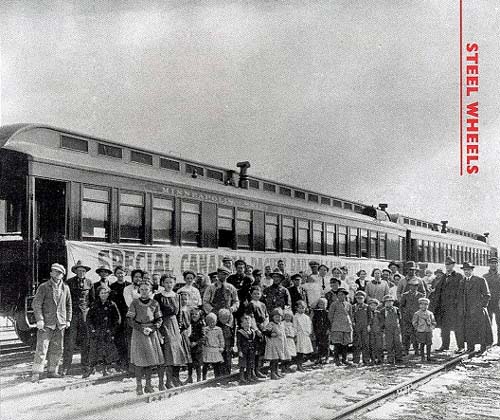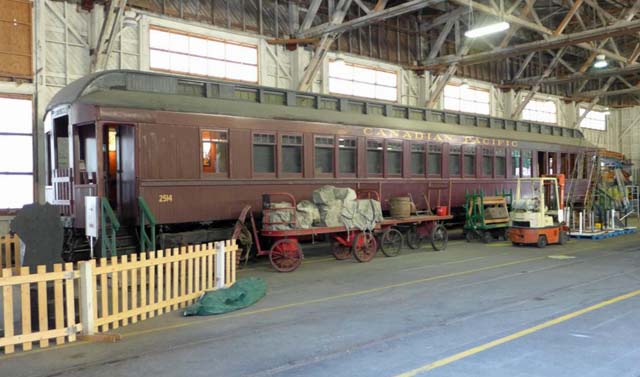
It's the railway, the Canadian Pacific Railway, that physically united Canada as a nation. But it's the people who actually built the country. And
no other rail car did more to fill the Canadian nation with people than the CPR colonist car.
A century ago, travelling on CPR colonist cars was the equivalent to today's no-frills flying. Elsewhere on a transcontinental train, travelers would
sit, eat, drink, and sleep in fine style. But the colonist car offered just the basics of century-old rail travel with all extras being just that,
extras. Food, blankets, pillows, bedding, and even berth curtains were all available to the to the colonist car guest for an extra fee. Food was
available if a dining car was part of the train's consist. If not, you just broke out some snacks or heated something up on the car's kitchen range at
the end of the passenger compartment across from the ladies' room. CPR's famous wool blankets were rented out at a dollar each, the same price as a
mattress. Pillows went for 35 cents, and berth curtains, for privacy, cost a dollar a pair. Most immigrants on tight budgets did without the frills.
They spent several days in these mobile homes in cramped quasi-comfort, travelling from the immigrant ship that off-loaded them at the ports of
Halifax, Saint John, Quebec City, and later Montreal to their new homesteads or CPR ready-made farms on the Prairies.

A typical wooden colonist car from a hundred years ago had 14 sections (two bare wood benches and a pull down upper berth) in the true third-class
part of the car that could seat 56 people. It also had a four-section, second-class portion or smoking section, seating 16, that featured upholstered
leather benches and berth curtains. There was also a ladies' room and a kitchenette at one end of the car. And there was a men's room for smoking at
the other end of the car. Despite these rudimentary accommodations immigrants flocked to Canada, especially from Europe where, most notably in the
United Kingdom, many CPR and Government of Canada immigration initiatives enticed immigrants to come to Canada. In the first decade of the 20th
century, Canada's population increased by one-third, from 5.3 to 7.2 million.
Sometimes there were dips in immigration. No matter. CPR redeployed its excess colonist cars to other duties... some even more intriguing than
populating Canada with its future lifeblood. During times of war, colonist cars moved troops there and back, including the Riel Rebellion, The Boer
War, and of course, both world wars. Colonist cars also moved many Ukrainian Canadians to internment camps in the First World War. Some of these
colonist cars, specially equipped with bars over the windows, would move Chinese immigrants in bond who couldn't afford Canada's $500-per-person head
tax. Colonist cars also served on fast moving silk trains and gold trains, and were converted for ranchers to use as drover cars.
More than a thousand colonist cars brought millions of new immigrants to Canada. Yet only two relatively-intact, wooden CPR colonist cars exist today.
The 1905 colonist car CP 2514 is at the West Coast Railway Association's museum in Squamish, B.C., while the 1912 colonist car CP 2658 awaits approval
for a million-dollar restoration at Calgary's Heritage Park.
OKthePK Joint Bar Editor: Canadian Pacific's car number 2658 was discovered to actually be 1201 during reconstruction. It was
subsequently re-numbered 1202 following completion of rebuilding at Heritage Park.


